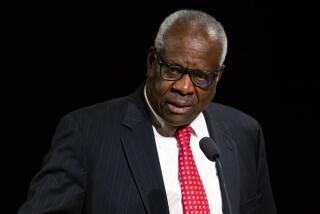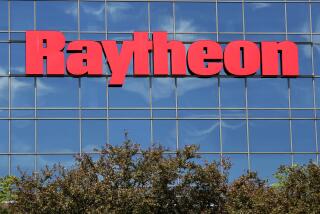The Defense Contractors Vs. Claims of Corruption : Fraud: Whistle-Blowers finally win a couple of battles against government contractors who allegedly cooked the books at taxpayersâ expense.
WASHINGTON â For two decades whistle-blowers have been castigated, blackballed, shunned, maligned, ruined, punished and generally made to suffer for bringing to light what they believed were crimes against the taxpayer.
This has been the one-sided story both whistle-blower and persecutor have been happy to advance. On the whistlerâs side is pride in sacrifices made, while the tormentor enjoys a mean image because it helps discourage other whistle-blowers. Consequently, a change in law and public thinking has gone largely unnoticed. It is an awesome change, nonetheless.
Look back 21 years, when A. Ernest Fitzgerald was first called before Congressâ Joint Economic Committee and asked if there was a $2-billion overrun on Lockheedâs C-5A transport plane. Fitzgerald, now a Washington celebrity, was then an unknown civilian working for the Air Force in financial management. He didnât come right out and tell the truth but he didnât lie either; when Sen. William Proxmire (D-Wis.) was through, it was clear there was a problem with the C-5A. Back then, the solution was simple. Fitzgerald was fired. âMost of the people I knew didnât know me any more,â he says today.
The same story was repeated with 100 different whistle-blowers in succeeding years. The results were usually more devastating for the whistle-blower. (Fitzgerald ultimately got his job back after a four-year court battle that cost him $60,000.)
But early this year in Cincinnati, a group of lawyers signed a partially secret agreement that made new history. General Electric Co. settled a lawsuit filed by a former employee named John M. Gravitt. Gravitt had accused GE of cheating the Pentagon on jet engine contracts. In the settlement, GE got rid of three other lawsuits--filed, like Gravittâs, by private whistle-blowers represented by one attorney, James B. Helmer Jr. All four suits accused GE of presenting false claims to the government.
But what drove GE to settlement, according to Helmer, was Gravitt. Here was a credible plaintiff who had proven his patriotism in Vietnam and who in 1984 accused GE of fraud against the taxpayer. Like other GE jet-engine workers, Gravitt had to indicate on his time card which projects he worked on. Gravittâs supervisors allegedly rewrote those time cards and thousands of others.
Misallocation of labor costs is a common form of defense fraud because while some government contracts have a fixed price, others reimburse for costs plus a percentage for profit. If a contractor has both kinds of contracts and can shift costs from fixed to cost-plus contracts, he can be reimbursed for something supposed to be paid out of his own pocket.
Whether GEâs misallocation was to cheat the government or not remains in dispute. GE said the cost-shifting was just an embarrassing mistake meant to better match budgets and, on balance, didnât cost the government anything. Gravitt said that was a joke, and he could prove it. With the settlement, the public will never really know; part of the agreement called for Gravitt to return all GE documents obtained in discovery.
But the settlementâs importance is that GE agreed to pay $5 million and give up another $1.4 million it had won in an unrelated case. Of that amount, the government got $4.7 million. Gravitt, the other whistle-blowers and lawyer Helmer received the rest. A pittance, compared to the $300-million liability GE faced. And to keep from paying even $6.4 million, GE used every maneuver in the book, including more than 100 pretrial motions, one of which went to the U.S. Supreme Court. In the end, Gravitt made enough money to warrant the trouble. That in itself was a landmark.
Settlement came five days before GE was to become the first government contractor facing a jury in a private whistle-blower case since World War II. Perhaps GEâs willingness to settle had something to do with public sentiment about contractors and whistle-blowers; no contractor wants to plumb the depth of that feeling before a jury.
In 1986, mounting hostility toward government contractors in general--defense contractors in particular--impelled an amendment to the False Claims Act. The act already allowed private citizens to sue contractors on behalf of the government and share in the recovery but the amendment made it much easier.
Now a contractor who submits false claims can be made to pay the government three times the amount of the false claims and to pay $5,000 to $10,000 for each false certification. The whistle-blower may get up to 30% of the recovery. More, a guilty contractor must pay for the whistle-blowerâs lawyer.
This is terrifying law from the contractorâs view. But until GE settled with Gravitt, there was no concrete evidence that it made any difference.
Then, when contractors were hoping Gravitt might be an aberration, along came George G. Butenkoff, a disgruntled ex-salesman for Industrial Tectonics Inc., a manufacturer of ball bearings for Pratt and Whitney aircraft engines. All Butenkoff knew was what any citizen could have learned with one phone call--the price of ball bearings. But that was enough.
Butenkoff watched prices drop precipitously as competitors entered the market. With no more direct evidence than that, he decided the company must have engaged in cost-and-pricing fraud--when a contractor sits down to negotiate a sole-source contract and misrepresents cost so the government will pay more.
Butenkoffâs grudge turned into a lawsuit after he read a magazine article about Gravitt. He went to a well-known Philadelphia lawyer who didnât even know what a whistle-blower lawsuit was. But with a little research, he found out and filed a complaint. No expensive discovery. No trial. The Justice Department stepped in, investigated and negotiated a June settlement for $14.3 million--$1.4 million of it to Butenkoff.
Lawyers across the land raised eyebrows, pulled down copies of the False Claims Act and smiled, including attorneys who defend contractors. (Among the biggest bills for crooked contractors are their own lawyersâ fees.)
For contractors, it was a nightmare come true. To them, the law is unfair in the first place, a kind of outright bribery that induces employees to take evidence of wrongdoing straight to the courthouse instead of trying to correct it. The contractorsâ last line of defense is the perception of their own invulnerability. It is a dike that restrains a sea of litigation by untold thousands of honest or frustrated or disgruntled or just plain clever insiders, who know about uncounted billions in honest mistakes and outright frauds that go back more than 10 years. This year, the dike cracked.
There is no moral to this story, only a prediction. The good news: Contractor house-cleaning is underway. The bad news: It wonât come cheap. For lack of leadership and integrity in government, the courts are about to become the hands-on overseers of federal procurement. That in itself will cost plenty. Beyond that, contractors who perish will leave less competition for those that survive. For them, the cost of litigation must go somewhere. And there is only one logical place: the taxpayer.
More to Read
Get the L.A. Times Politics newsletter
Deeply reported insights into legislation, politics and policy from Sacramento, Washington and beyond. In your inbox three times per week.
You may occasionally receive promotional content from the Los Angeles Times.










